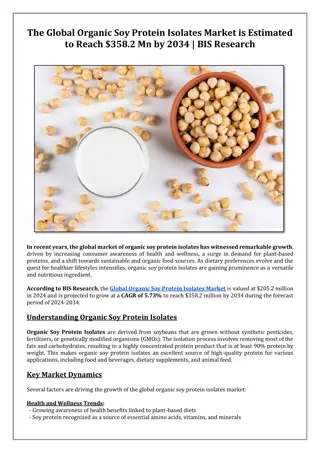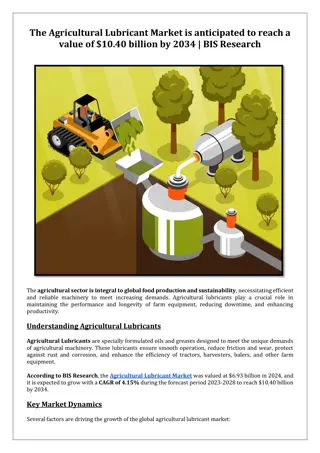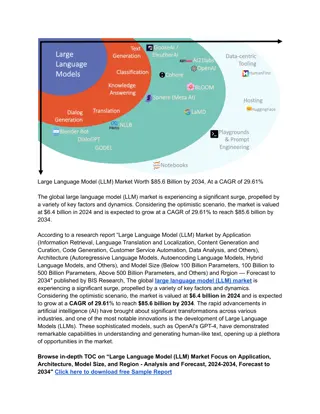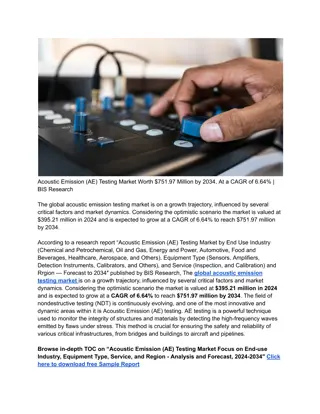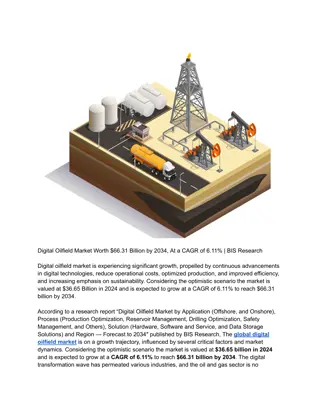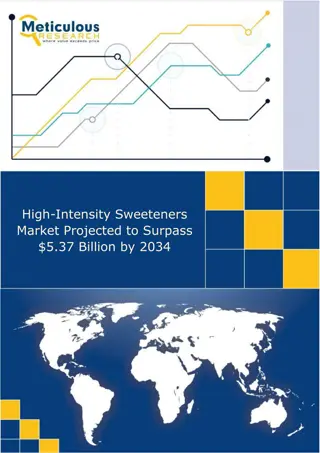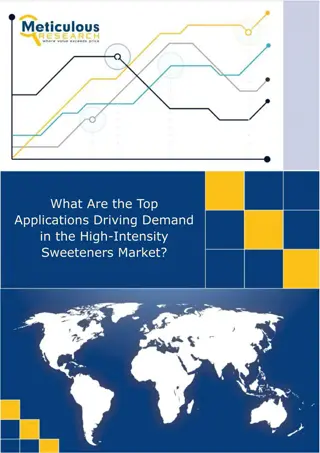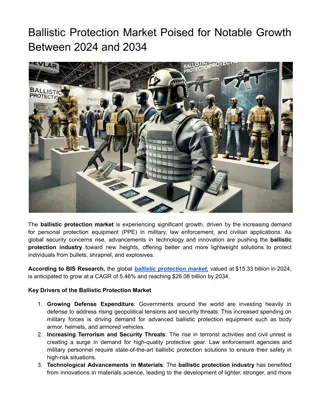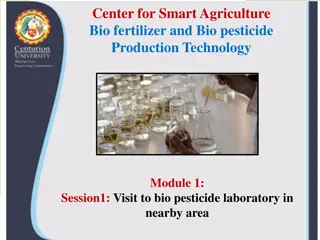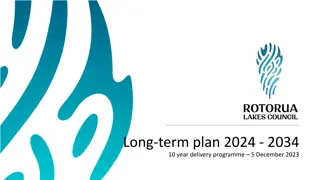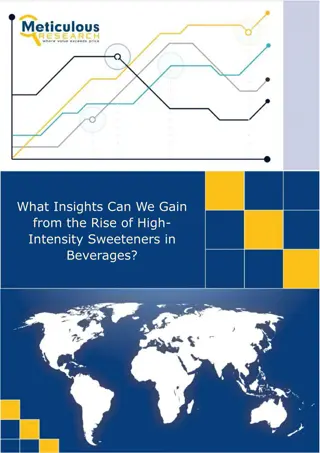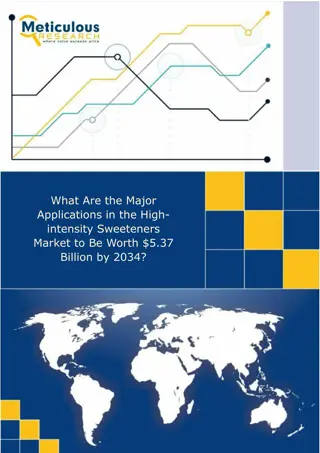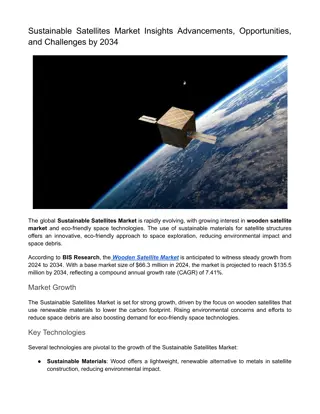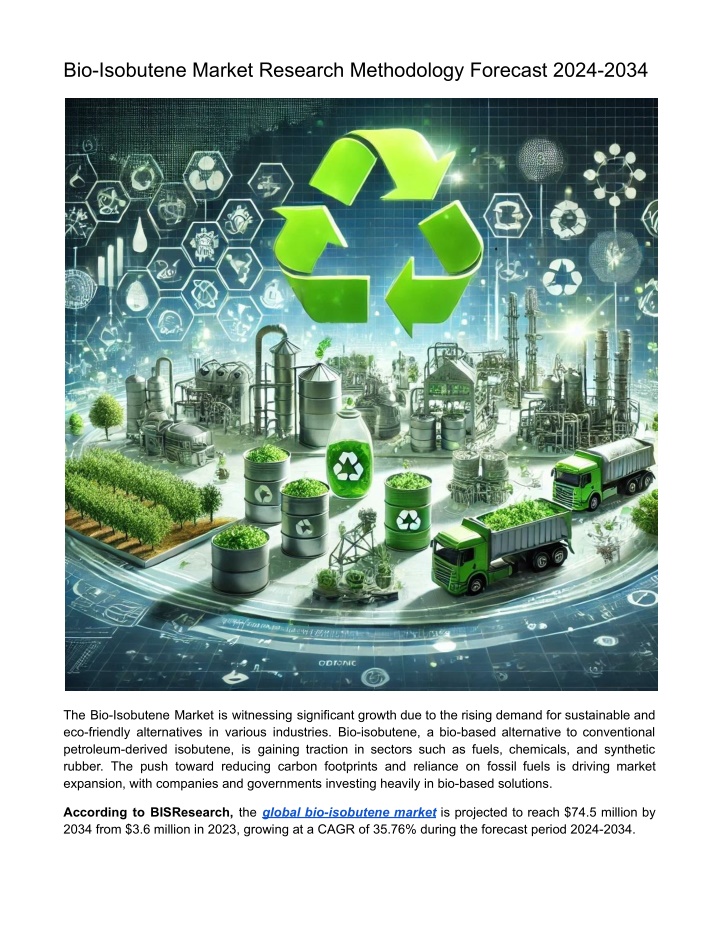
Bio-Isobutene Market Research Methodology Forecast 2024-2034
The global bio-isobutene market is projected to reach $74.5 million by 2034 from $3.6 million in 2023, growing at a CAGR of 35.76% during the forecast period 2024-2034.nnRead Report Overview: //bisresearch.com/industry-report/bio-isobutene-mark
Download Presentation

Please find below an Image/Link to download the presentation.
The content on the website is provided AS IS for your information and personal use only. It may not be sold, licensed, or shared on other websites without obtaining consent from the author. If you encounter any issues during the download, it is possible that the publisher has removed the file from their server.
You are allowed to download the files provided on this website for personal or commercial use, subject to the condition that they are used lawfully. All files are the property of their respective owners.
The content on the website is provided AS IS for your information and personal use only. It may not be sold, licensed, or shared on other websites without obtaining consent from the author.
E N D
Presentation Transcript
Bio-Isobutene Market Research Methodology Forecast 2024-2034 The Bio-Isobutene Market is witnessing significant growth due to the rising demand for sustainable and eco-friendly alternatives in various industries. Bio-isobutene, a bio-based alternative to conventional petroleum-derived isobutene, is gaining traction in sectors such as fuels, chemicals, and synthetic rubber. The push toward reducing carbon footprints and reliance on fossil fuels is driving market expansion, with companies and governments investing heavily in bio-based solutions. According to BISResearch, the global bio-isobutene market is projected to reach $74.5 million by 2034 from $3.6 million in 2023, growing at a CAGR of 35.76% during the forecast period 2024-2034.
Market Drivers: Environmental Regulations and Policies Environmental regulations play a crucial role in driving the global bio-isobutene market by creating favorable economic and legal conditions for bio-based products. The EU s Renewable Energy Directive (RED II) mandates member states to achieve 14% renewable energy in transportation by 2030, promoting biofuels like bio-isobutene. Companies such as Global Bioenergies leverage these regulations, benefiting from subsidies and tax incentives to develop and market bio-isobutene. Bio-Based Cosmetic Ingredients to Dominate the Bio-Isobutene Market The bio-isobutene market is led by the bio-based cosmetic ingredients segment, driven by rising consumer demand for natural and sustainable products. With increasing environmental awareness and regulatory pressures, the cosmetics industry is shifting toward renewable materials. Bio-isobutene, derived from renewable sources, serves as an eco-friendly alternative to petrochemical-based components. Companies like Global Bioenergies are pioneering its use, enhancing cosmetic formulations while maintaining durability and performance. Bio-Isobutene Market by Region: Europe emerged as the fastest-growing market for bio-isobutene, recording a CAGR of 41.42%. The region s strong manufacturing infrastructure and the presence of key players like France-based Global Bioenergies, the only company globally producing bio-isobutene, drive adoption. Request A Detailed Sample on the Bio-Isobutene Market! Among European countries, Rest-of-Europe is expected to witness the highest growth at a CAGR of 48.55%, with the Netherlands benefiting from government support and a thriving ecosystem of innovative companies and startups. Market Opportunities: Integration with Circular Economy Initiatives Companies in the global bio-isobutene market, along with those in the bio-based chemicals ecosystem, can capitalize on significant market opportunities by aligning with circular economy initiatives. Bio-isobutene production aligns with circular economy principles, promoting resource sustainability through material reuse and recycling. By utilizing industrial emissions, municipal solid waste, and agricultural by-products as feedstocks, companies reduce dependence on primary resources while addressing waste management challenges. Enerkem's process, for example, converts municipal solid waste into syngas to produce bio-isobutene, demonstrating waste's potential as a valuable resource. Future Outlook The Bio-Isobutene Market is expected to experience strong growth, driven by increasing environmental awareness, regulatory support, and advancements in bio-refining technologies. The transition toward a circular bioeconomy and the adoption of bio-based alternatives in various industries will further accelerate market expansion. Download Our ToC: Click Here!
Conclusion The Bio-Isobutene Market is emerging as a crucial segment in the sustainable chemical industry. Despite challenges such as high production costs and competition from petroleum-based alternatives, the market is set to thrive due to increasing investments, regulatory support, and growing demand for renewable chemicals. As technological advancements improve cost efficiency and scalability, bio-isobutene is expected to play a key role in the global shift toward sustainable industrial solutions.


![Global Medical Robots Market Research Analysis & Forecast [2024-2034]](/thumb/86013/global-medical-robots-market-research-analysis-forecast-2024-2034.jpg)
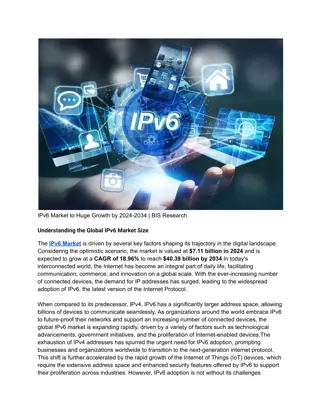
![Mass Notification System Market Size, Report & Forecast _ BIS Research [2024-2034]](/thumb/86971/mass-notification-system-market-size-report-forecast-bis-research-2024-2034.jpg)
